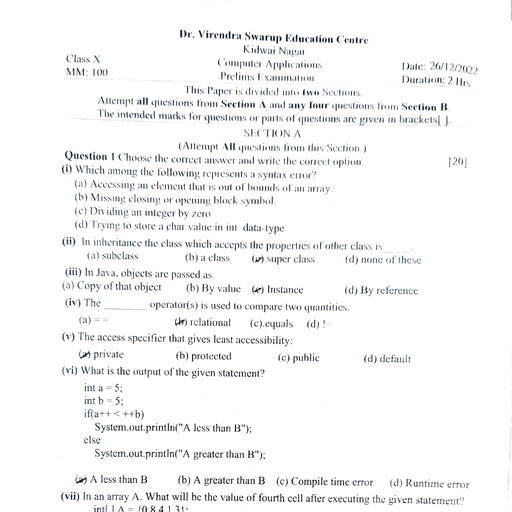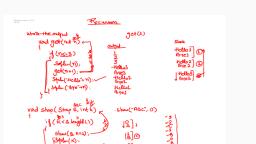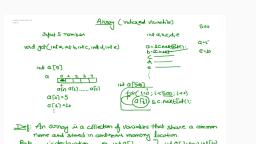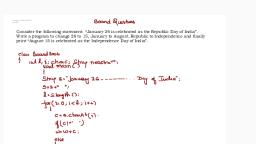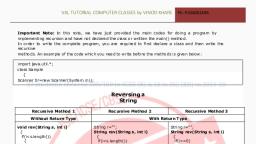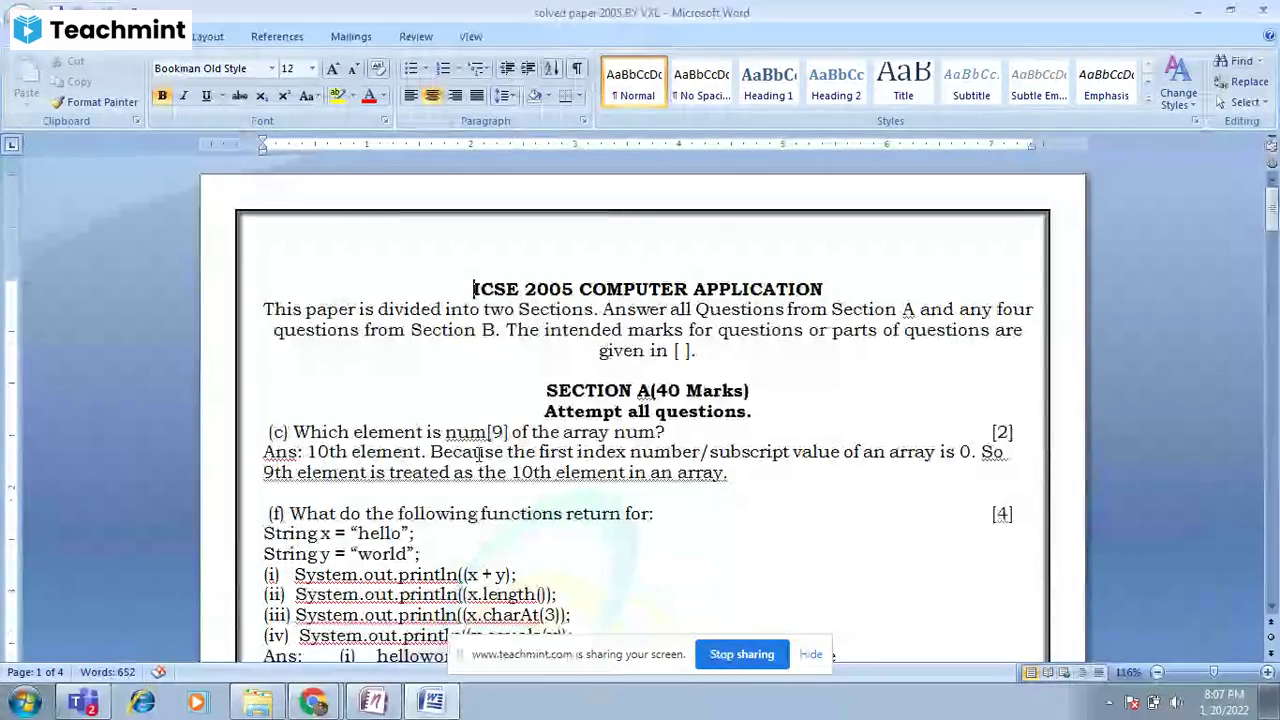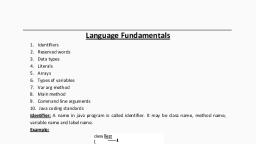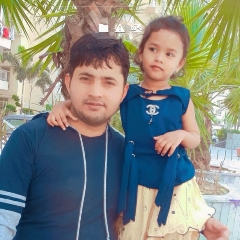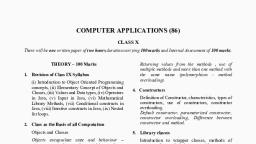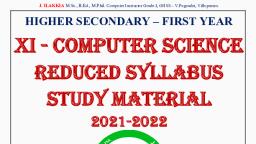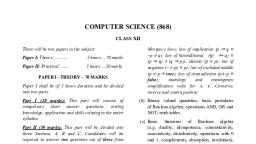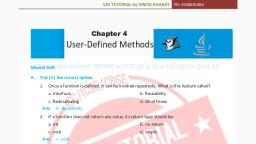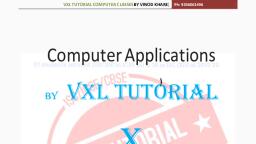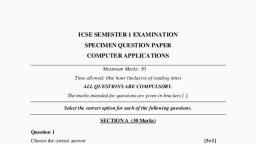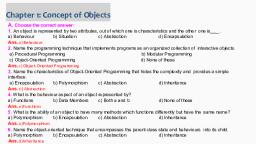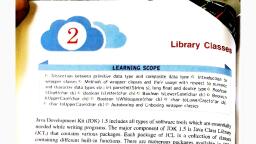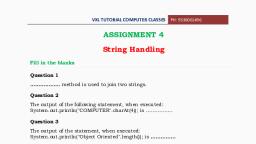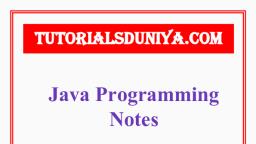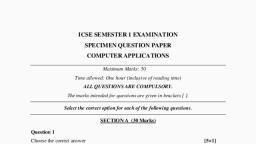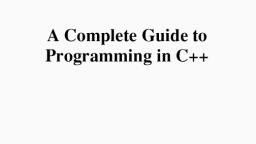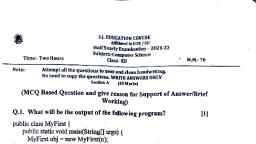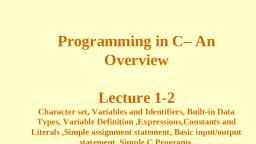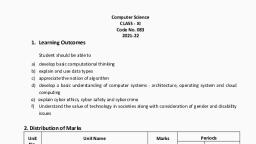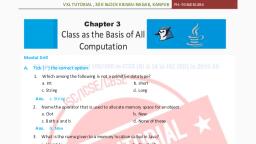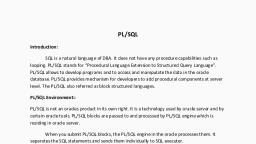Page 1 :
COMPUTER APPLICATIONS (86), CLASS X, There will be one written paper of two hours duration, carrying 100 marks and Internal Assessment of, 100 marks., , Object creation - invoking the methods with, respect to use of multiple methods with different, names to implement modular programming, using, data members and member methods, Actual, parameters and formal parameters, Declaration, of methods - static and non-static, method, prototype / signature, - Pure and impure methods,, - pass by value [with programs] and pass by, reference [only definition with an example],, Returning values from the methods , use of, multiple methods and more than one method with, the same name (polymorphism - method, overloading)., , The paper will be divided into two sections A and B., Section A (Compulsory – 40 marks) will consist of, compulsory short answer questions covering the entire, syllabus., Section B (60 marks) will consist of questions which, will require detailed answers. There will be a choice, of questions in this section, THEORY – 100 Marks, 1. Revision of Class IX Syllabus, , 4. Constructors, , (i) Introduction to Object Oriented Programming, concepts, (ii) Elementary Concept of Objects and, Classes, (iii) Values and Data types, (iv) Operators, in Java, (v) Input in Java, (vi) Mathematical, Library Methods, (vii) Conditional constructs in, Java, (viii) Iterative constructs in Java., , Definition of Constructor, characteristics, types of, constructors, use of constructors, constructor, overloading., Default constructor, parameterized constructor,, constructor overloading., Difference between, constructor and method., 5. Library classes, , 2. Class as the Basis of all Computation, , Introduction to wrapper classes, methods of, wrapper class and their usage with respect to, numeric and character data types. Autoboxing and, Unboxing in wrapper classes., , Objects and Classes, Objects encapsulate state and behaviour –, numerous examples; member variables; attributes, or features. Variables define state; member, methods; Operations/methods/messages/ methods, define behaviour., Classes as abstractions for sets of objects; class, as an object factory; primitive data types,, composite data types. Variable declarations for, both types; difference between the two types., Objects as instances of a class., Consider real life examples for explaining the, concept of class and object., , Class as a composite type, distinction between, primitive data type and composite data type or, class types. Class may be considered as a new, data type created by the user, that has its own, functionality. The distinction between primitive, and composite types should be discussed through, examples. Show how classes allow user defined, types in programs. All primitive types have, corresponding class wrappers. Introduce, Autoboxing and Unboxing with their definition, and simple examples., , 3. User - defined Methods, , The following methods are to be covered:, , Need of methods, syntax of methods, forms of, methods, method definition, method calling,, method overloading, declaration of methods,, , int parseInt(String s),, long parseLong(String s),, , Ways to define a method, ways to invoke the, methods – call by value [with programs] and call, by reference [only definition with an example],, , float parseFloat(String s),, double parseDouble(String s),, 1
Page 2 :
boolean isDigit(char ch),, , String concat(String str), , boolean isLetter(char ch),, , boolean equals (String str), , boolean isLetterOrDigit(char ch),, , boolean equalsIgnoreCase(String str), , boolean isLowerCase(char ch),, , int compareTo(String str), , boolean isUpperCase(char ch),, , int compareToIgnoreCase(String str), String replace (char oldChar,char newChar), , boolean isWhitespace(char ch),, , String substring (int beginIndex), , char toLowerCase (char ch), , String substring (int beginIndex, int endIndex), , char toUpperCase(char ch), , boolean startsWith(String str), , 6. Encapsulation, , boolean endsWith(String str), , Access modifiers and its scope and visibility., , String valueOf(all types), , Access modifiers – private, protected and public., Visibility rules for private, protected and public, access modifiers. Scope of variables, class, variables, instance variables, argument variables,, local variables., , Programs based on the above methods, extracting, and modifying characters of a string, searching, for a string using linear search technique., INTERNAL ASSESSMENT - 100 Marks, , 7. Arrays, , This segment of the syllabus is totally practical, oriented. The accent is on acquiring basic, programming skills quickly and efficiently., , Definition of an array, types of arrays, declaration,, initialization and accepting data of single, dimensional array, accessing the elements of, single dimensional array., , Programming Assignments (Class X), The students should complete a minimum of, 20 laboratory assignments during the whole year to, reinforce the concepts studied in class., , Arrays and their uses, Search techniques – linear, search and binary search, Array as a composite, type, length statement to find the size of the array, (searching techniques using single dimensional, array only)., , Suggested list of Assignments:, The laboratory assignments will form the bulk of the, course. Good assignments should have problems, which require design, implementation and testing., They should also embody one or more concepts that, have, been, discussed in the theory class. A, significant proportion of the time has to be spent in the, laboratory. Computing can only be learnt by doing., , 8. String handling, String class, methods of String class,, implementation of String class methods, String, array, The following String class methods are to be, covered:, , The teacher-in-charge should maintain a record of all, the assignments done by the student throughout the, year and give it due credit at the time of cumulative, evaluation at the end of the year., , String trim (), String toLowerCase(), String toUpperCase(), , Some sample problems are given below as examples., The problems are of varying levels of difficulty:, , int length( ), , (i) User defined methods, (a) Programs depicting the concept of pure,, impure, static, non- static methods., , char charAt (int n), int indexOf(char ch), int lastIndexOf(char ch), , (b) Programs based on overloaded methods., 2
Page 3 :
(c) Palindrome string, pig Latin, alphabetical, order of characters, etc., , (c) Programs involving data members, member, methods invoking the methods with respect to, the object created., , Important: This list is indicative only. Teachers and, students should use their imagination to create, innovative and original assignments., , (ii), , Constructors, (a) Programs based on different types of, constructors mentioned in the scope of the, syllabus., (b) Programs / outputs based on constructor, overloading, (iii) Library classes, , EVALUATION, The teacher-in-charge shall evaluate all the, assignments done by the student throughout the year, [both written and practical work]. He/she shall ensure, that most of the components of the syllabus have been, used appropriately in the assignments. Assignments, should be with appropriate list of variables and, comment statements. The student has to mention the, output of the programs., , (a) Outputs based on all the methods mentioned, in the scope of the syllabus., (b) Programs to check whether a given character, is an uppercase/ lowercase / digit etc., (iv) Encapsulation, , Proposed Guidelines for Marking, The teacher should use the criteria below to judge the, internal work done. Basically, four criteria are being, suggested: class design, coding and documentation,, variable description and execution or output. The, actual grading will be done by the teacher based on, his/her judgment. However, one possible way: divide, the outcome for each criterion into one of 4 groups:, excellent, good, fair/acceptable, poor/unacceptable,, then use numeric values for each grade and add to get, the total., , Questions based on identifying the different, variables like local, instance, arguments, private,, public, class variable etc., (v), , Arrays, (a) Programs based on accessing the elements of, an array., (b) Programs based on search techniques, mentioned in the scope of the syllabus., , (vi) String handling, , Class design:, Has a suitable class (or classes) been used?, Are all attributes with the right kinds of types present?, Is encapsulation properly done?, Is the interface properly designed?, , (a) Outputs based on all the string methods, mentioned in the scope of the syllabus., (b) Programs based on extracting the characters, from a given string and manipulating the, same., , 3
Page 4 :
Coding and documentation:, , EQUIPMENT, , Is the coding done properly? (Choice of names, no, unconditional jumps, proper organization of, conditions, proper choice of loops, error handling,, code layout) Is the documentation complete and, readable?, (class, documentation,, variable, documentation, method documentation, constraints,, known bugs - if any)., , There should be enough computer systems to provide, for a teaching schedule where at least three-fourth of a, time available is used for programming and, assignments/practical work. The course shall require, at least 4 periods of about 40 minutes duration per, week. In one week, out of 4 periods the time should be, divided as follows:, , Variable description:, Format for variable description:, Name of the, Variable, , Data, Type, , Purpose/description, , Evaluation of practical work will be done as, follows:, , 50 marks, , Criteria, (Total50, marks), , Class, design, (10, marks), , Variable, description, (10 marks), , Coding and, Documentation, (10 marks), , Execution, OR, Output, (20, marks), , Excellent, , 10, , 10, , 10, , 20, , Good, , 8, , 8, , 8, , 16, , Fair, , 6, , 6, , 6, , 12, , Poor, , 4, , 4, , 4, , 8, , SOFTWARE FOR CLASSES IX & X, Any suitable Operating System can be used., , An External Examiner shall be nominated by the Head, of the School and may be a teacher from the faculty,, but not teaching the subject in the relevant, section/class. For example, A teacher of Computer, Science of class VIII may be deputed to be the, External Examiner for class X., , For teaching fundamental concepts of computing, using object oriented approach, Blue J environment, (3.2 or higher version) compatible with JDK (5.0 or, higher version) as the base or any other editor or IDE,, compatible with JDK (5.0 or higher version) as the, base may be used. Ensure that the latest versions of, software are used., , The total marks obtained out of 100 are to be sent to, the Council by the Head of the school., The Head of the school will be responsible for the, online entry of marks on the Council’s CAREERS, portal by the due date., , 2 periods – Assignments/Practical work., , RECOMMENDED FACILITIES:, • A lecture cum demonstration room with a, MULTIMEDIA PROJECTOR/ an LCD and, Overhead Projector (OHP) attached to the, computer., • A white board with white board markers should be, available., • A fully equipped Computer Laboratory that allows, one computer per student., • The computers should have a minimum of, 1 GB RAM and at least a P - IV or Equivalent, Processor., • Good Quality printers., • A scanner, a web cam/a digital camera (Should be, provided if possible)., , 50 marks, , External Examiner, , •, , Since hardware and software evolve and change very, rapidly the schools shall need to upgrade them as, required. Following are the minimal specifications as, of now., , Does the program run on all sample input correctly?, , (Internal, , 2 periods – Lecture cum demonstration by the, instructor., , The hardware and software platforms should be such, that students can comfortably develop and run, programs on those machines., , Execution or Output:, , Subject, Teacher, Examiner), , •, , 4



